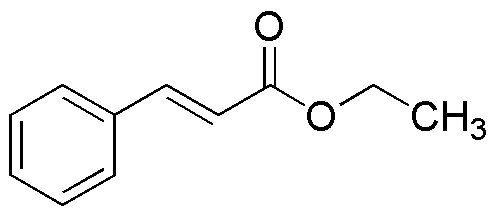Phenethyl cinnamate is widely utilized in research focused on
- Fragrance Industry: This compound is commonly used in perfumes and scented products due to its pleasant aroma, enhancing the overall sensory experience for consumers.
- Food Flavoring: It serves as a flavoring agent in various food products, providing a sweet and fruity taste that appeals to consumers' palates.
- Cosmetics: In skincare and cosmetic formulations, it acts as a fragrance component and may also offer some skin-conditioning properties, making products more appealing.
- Pharmaceuticals: It is explored for its potential therapeutic properties, including anti-inflammatory effects, which can be beneficial in developing new medications.
- Research Applications: In chemical research, it is used as a model compound to study esterification reactions and the behavior of aromatic compounds, aiding in the development of new synthetic methods.
Información general
Propiedades
Seguridad y normativas
Aplicaciones
Phenethyl cinnamate is widely utilized in research focused on
- Fragrance Industry: This compound is commonly used in perfumes and scented products due to its pleasant aroma, enhancing the overall sensory experience for consumers.
- Food Flavoring: It serves as a flavoring agent in various food products, providing a sweet and fruity taste that appeals to consumers' palates.
- Cosmetics: In skincare and cosmetic formulations, it acts as a fragrance component and may also offer some skin-conditioning properties, making products more appealing.
- Pharmaceuticals: It is explored for its potential therapeutic properties, including anti-inflammatory effects, which can be beneficial in developing new medications.
- Research Applications: In chemical research, it is used as a model compound to study esterification reactions and the behavior of aromatic compounds, aiding in the development of new synthetic methods.
Documentos
Hojas de datos de seguridad (HDS)
La SDS proporciona información de seguridad completa sobre la manipulación, el almacenamiento y la eliminación del producto.
Especificación del producto (PS)
La PS proporciona un desglose completo de las propiedades del producto, incluida la composición química, el estado físico, la pureza y los requisitos de almacenamiento. También detalla los rangos de calidad aceptables y las aplicaciones previstas del producto.
Certificados de análisis (COA)
Busque certificados de análisis (COA) ingresando el número de lote del producto. Los números de lote y de partida se pueden encontrar en la etiqueta de un producto después de las palabras "Lote" o "Lote".
Número de catálogo
Número de lote/lote
Certificados de origen (COO)
Este certificado de origen confirma el país en el que se fabricó el producto y también detalla los materiales y componentes utilizados en él y si se deriva de fuentes naturales, sintéticas u otras fuentes específicas. Este certificado puede ser necesario para cumplir con las normativas aduaneras, comerciales y regulatorias.
Número de catálogo
Número de lote/lote
Hojas de datos de seguridad (HDS)
La SDS proporciona información de seguridad completa sobre la manipulación, el almacenamiento y la eliminación del producto.
DownloadEspecificación del producto (PS)
La PS proporciona un desglose completo de las propiedades del producto, incluida la composición química, el estado físico, la pureza y los requisitos de almacenamiento. También detalla los rangos de calidad aceptables y las aplicaciones previstas del producto.
DownloadCertificados de análisis (COA)
Busque certificados de análisis (COA) ingresando el número de lote del producto. Los números de lote y de partida se pueden encontrar en la etiqueta de un producto después de las palabras "Lote" o "Lote".
Número de catálogo
Número de lote/lote
Certificados de origen (COO)
Este certificado de origen confirma el país en el que se fabricó el producto y también detalla los materiales y componentes utilizados en él y si se deriva de fuentes naturales, sintéticas u otras fuentes específicas. Este certificado puede ser necesario para cumplir con las normativas aduaneras, comerciales y regulatorias.

